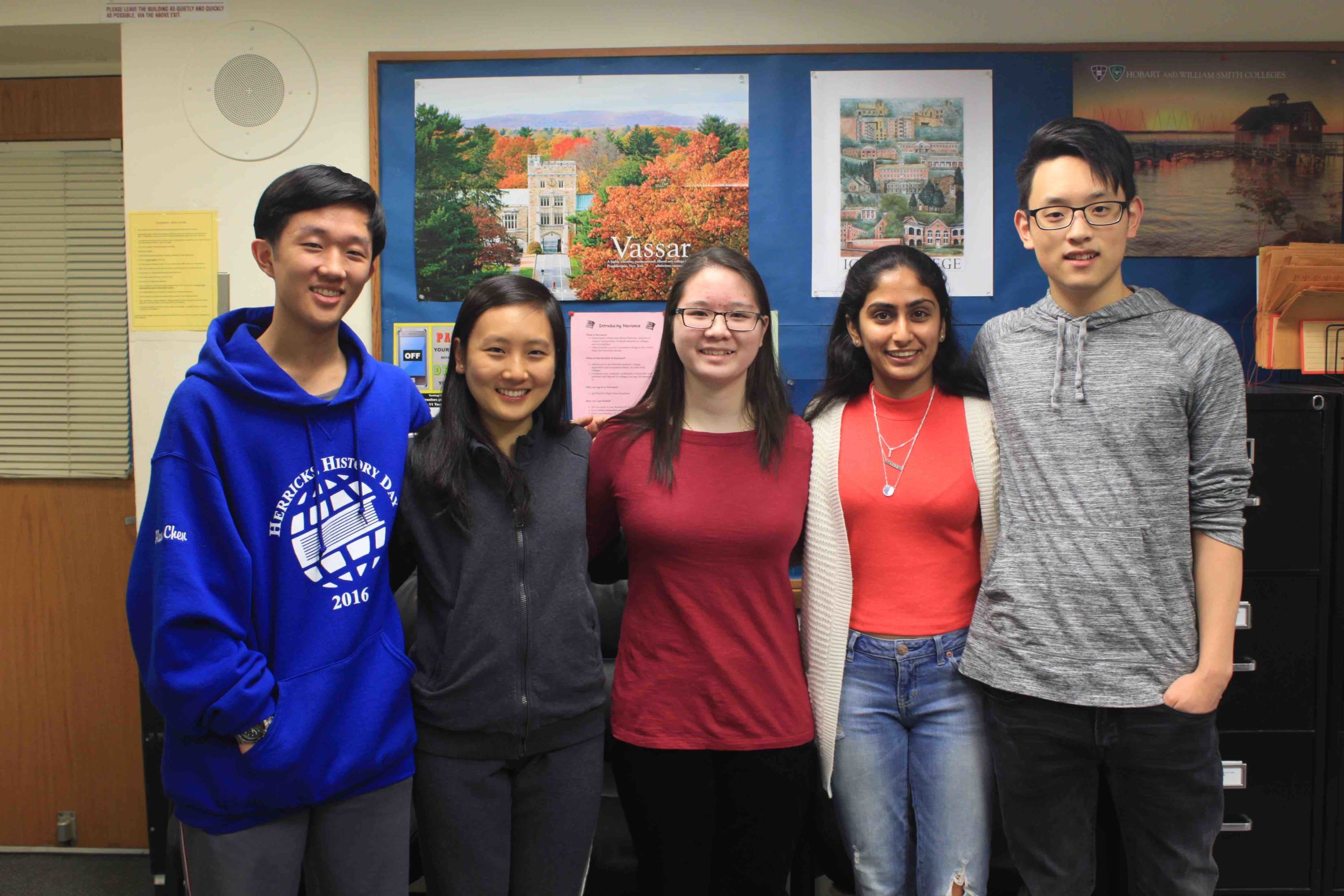One project studied how to protect encrypted computer messages from hackers. Another could inform how geologists study rocks on Mars. And three others could have big implications for how to treat diseases, including some forms of cancer.
The five Herricks High School seniors who made the semifinal round of the Regeneron Science Talent Search — a record number for the school — have wide-ranging scientific interests and varying reasons they chose their research projects.
But Natalie Tan, Seta Mehtu, Nora Koe, Alan Chen and Bongseok Jung said they share an intense curiosity and a desire to learn more about the world around them.
“By exposing yourself to different fields of research, you not only get to explore your passions for learning more things about the world, but also you get … the additional benefit of helping others in the process,” Mehtu said.
The students were among 16 Herricks seniors who applied to the national contest for top high school science research students, said Renee Barcia, director of Herricks’ science research program.
Regeneron, a Westchester County-based medical technology company, named 300 “scholars” last week from high schools across the country, including 17 other students from the North Shore area. Forty finalists to be named Jan. 24 will compete for $1.8 million in awards in Washington, D.C., in March.
The Regeneron contest isn’t the first stroke of success for Tan and Jung. Both were named to the semifinals of the Siemens Competition in Math, Science and Technology in the fall, a distinction Jung has gotten the past three years. He was named a finalist in 2015.
The Herricks students have all been in the school’s science research program for four years and worked with professional research mentors at major New York area institutions, including Columbia University, Stony Brook University and Manhasset’s Feinstein Institute for Medical Research.
Motivated by the cancer deaths of three of his grandparents, Jung, an Albertson resident, embarked on a three-year study to find a safe and effective treatment for colon cancer.
“All these labs, they had their own projects going and I just had to join in with their projects, whatever they were being funded for, so I was motivated to do my own research, start from the beginning, fund myself,” Jung said.
He examined two drugs: COX 2 inhibitors, which target cancer cells effectively but cause side effects like intestinal bleeding, and Salacin, which has no side effects but is far less effective at killing cancer.
When used simultaneously in certain concentrations, both worked to kill colon cancer cells without side effects while Salacin treated the disease’s other “hallmarks,” such as the development of new blood vessels that help it spread, Jung said.
Tan, also from Albertson, is a competitive figure skater and often puts on makeup for contests, she said.
Once she learned titanium dioxide nanoparticles, often used in sunscreens, are found in many cosmetics, she wanted to examine their potential health risks, she said.
“Knowing that people were putting on sunscreen every day, slathering it on, and it’s full of these particles that god knows what they do to you — it motivated me to keep going,” Tan said.
Her research project at Stony Brook University examined whether titanium dioxide and dextran, a sugar often used to treat diabetes, increased vulnerability to staph infections.
She found titanium dioxide nanoparticles weaken some cell membranes and increase their vulnerability to staph bacteria, she said. And dextran, widely believed to have anti-adhesive properties, actually made staph stick to cells more easily, she said.
Mehta, a New Hyde Park resident, investigated the connection between the presence of a protein, interferon regulatory factor 5, and the growth of breast cancer tumors.
Mehta got to work at the Feinstein Institute through its Advancing Women in Science and Medicine program. As a Girl Scout, the opportunity to work with women at the top of their fields on a disease that primarily affects women was one she was excited to tackle, she said.
Testing on live mice, Mehta’s research determined that lower amounts of the protein correlated with more cancer growth. The findings could help doctors predict how far breast cancer will progress in a patient, she said.
Koe, another New Hyde Park resident, worked with cryptography researchers at Columbia University to find a more efficient method of secret sharing, which distributes pieces of a secret computer message to a group of individuals.
Her project, which combined mathematics and theoretical computer science, found that certain computer formulas called Boolean formulas can be used to create secret-sharing schemes that better protect against certain hacking efforts, she said.
Chen, also from New Hyde Park, examined the effects of weathering on the chemical composition of basalt rocks using instruments similar to those planned for the rover NASA wants to send to Mars in 2020, he said.
He found the composition of certain chemical elements in the rocks changed over time, Chen said, contradicting scientists’ past findings.
“It is a small-scale study, but … that has an impact on how we analyze results from the Martian instrument,” he said.
The students’ appearance in the Regeneron semifinals continues the success of Herricks’ science research program on the national stage. Three students made the semifinals in last year’s contest, which was sponsored by Intel, the semiconductor chip company.
“I knew that this was a very special group, and was really hopeful that their potential would be recognized, and it was,” Barcia, the program’s director, said.
All five students said working with mentors who were so knowledgeable and advanced in their fields led to their projects’ successes.
But finishing and submitting an extensive research paper proved their own strengths, they said.
“I wasn’t expecting anything, but I proved to myself that I was able to do it, which taught me a lot about myself,” Koe said.



